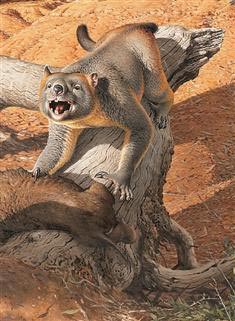A newly discovered genus and species of primitive carnivorous animal that lived in what is now Europe roughly 55 million years ago sheds light on the origins of lions, tigers and bears, says a team of paleontologists.

Reconstruction of Dormaalcyon latouri. Image credit: Charlène Letenneur, MNHN / Pascale Golinvaux, RBINS.
The fossil animal, scientifically named Dormaalocyon latouri, is one of the earliest ancestors of all modern-day carnivorous mammals (carnivoraforms).
“Its description allows better understanding of the origination, variability and ecology of the earliest carnivoraforms,” said Dr Floréal Solé from both the Royal Belgian Institute of Natural Sciences and the Muséum National d’Histoire Naturelle in France, the lead author of a paper published in the Journal of Vertebrate Paleontology.

Over 250 teeth and ankle bones of Dormaalocyon latouri have been unearthed at the Belgian locality of Dormaal. The finds include the deciduous teeth, or ‘baby teeth’.
The fact that these teeth are very primitive looking, and from a very early time, implies that Dormaalocyon latouri is close to the origin of carnivoraforms, and that this origin may have been in Europe.
The ankle bones suggest that Dormaalocyon latouri was a tree-dwelling mammal.
Previous reconstructions of the environment at Dormaal 55 million years ago inferred a warm, humid, and wooded area. This was a time soon after an event called the Paleocene-Eocene Thermal Maximum. This extremely warm period affected the evolution of many mammal groups, including carnivoraforms.

This image shows the fossils of Dormaalcyon latouri. Image credit: Charlène Letenneur, MNHN / Pascale Golinvaux, RBINS.
“The fact that Dormaalocyon latouri was arboreal, and that carnivoraforms made their way to North America around this time, supports the existence of a continuous evergreen forest belt at high latitudes during the Paleocene-Eocene Thermal Maximum,” Dr Solé explained.
Although close to the origin of carnivoraforms, the fossils suggest there were even more primitive species in the group in an earlier time period, the Paleocene.

“The understanding of the origination of the carnivoraforms is important for reconstructing the adaptation of placental mammals to carnivorous diet. Therefore, Dormaalocyon latouri provides information concerning the evolution of placental mammals after the disappearance of the largest dinosaurs at the Cretaceous–Paleogene extinction event.”

Dr Solé concluded: “our study shows that the carnivoraforms were very diversified at the earliest Eocene, which allows hypothesizing that they were probably already diversified during the latest Paleocene. This means there are more fossils out there to be found that can answer the question of the origin of this beloved modern group.”
Source: sci.news








